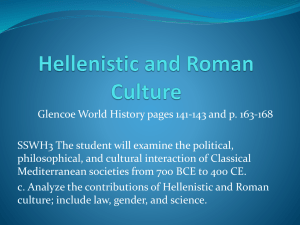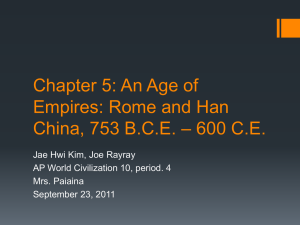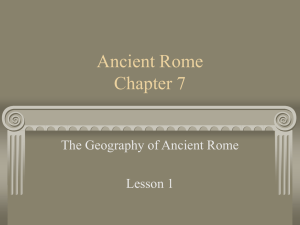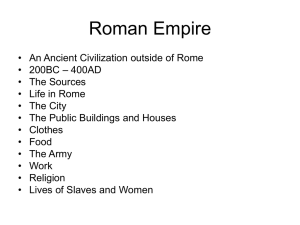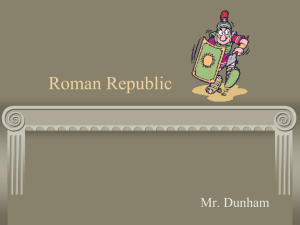Roman Daily Life
advertisement
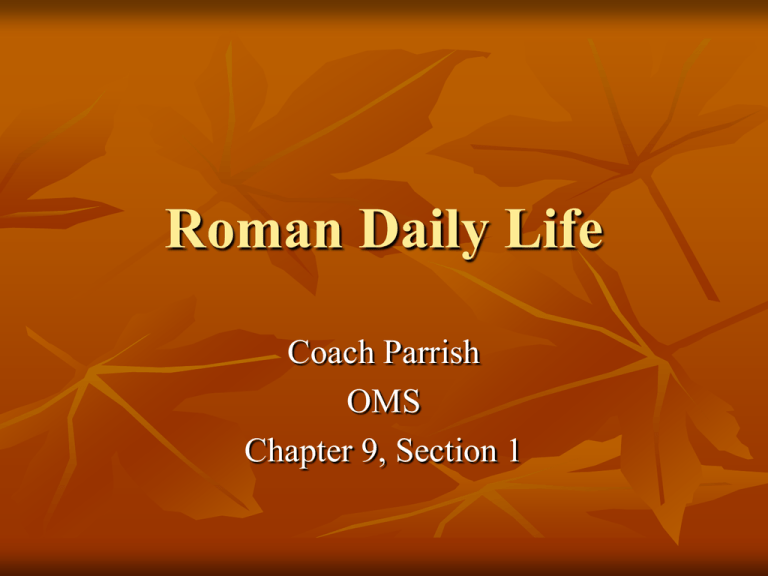
Roman Daily Life Coach Parrish OMS Chapter 9, Section 1 Roman Citizens Daily life for Rome’s citizens was a constant noisy and busy society. The poet Martial wrote, “Before it gets light, we have the bakers. Then it’s the hammering of the artisans all day. There’s no peace or quiet in this city.” The Average Roman Day Being Counted as a Citizen Despite overpopulated streets in Rome, citizens considered it an honor to be a citizen. During the republic, only citizens of Rome itself were citizens. Every five years, Roman men registered for the census – official count of people living in Rome. If a man didn’t register, he risked losing his property and being sold into slavery. Women, girls, slaves, and freed slaves were not counted as citizens. Example of a Roman Census Citizens and City As the Roman Empire expanded, people beyond Rome (city) gained citizenship. Even though people in Roman provinces were gaining citizenship, the people of Rome still considered themselves to be the greatest Roman citizens. The Path to Roman Citizenship Roman Social Classes Roman society was made up of a small number of rich people and many poor people and slaves. There was a huge difference between the lives of the rich and the poor. Most of Rome’s poor people only survived because of government handouts. Life of Luxury The rich often had elegant homes in the city. Many other rich people enjoyed villas – country estates. The rich often had feasts where they served game such as partridge or wild boar. Special occasions might bring flamingo or ostrich. These feasts also often had musicians or dancers. The Roman Feast Roman Villa Another Way of Life for the Poor Unlike the rich, the poor lived in rundown, poorly built apartment housing. Most didn’t have running water, toilets, or kitchens. All waste had to be carried down to the street or – as often happened – dumped out of a window. Roman Sanitation Bread and Circuses The poor needed wheat to survive. When the harvests were bad or when grain shipments from overseas were late, the poor often rioted. To prevent this from happening, emperors supplied free grain and provided spectacular shows. The shows were held in circuses (arenas), which eventually became their name. Bread and Circuses, cont. The circuses could often be violent. Romans packed these events which often included animals fighting each other, humans fighting animals, or humans fighting other humans. Other circuses might include clowns for entertainment, or public execution of criminals. The main events of the day were between gladiators – people who fought to the death. Gladiators Armor and Weapons Bread and Circuses, cont. Before the battles, the gladiators paraded onto the floor of the arena. They would approach the emperor’s box, salute, and shout “Hail, Caesar! We who are about to die salute you!” Men who performed well might be spared with a thumb’s up from the crowd. Gladiator Battles Support from the Government The Roman government provided family support, usually to the upper classes, in various ways. For example, under Julius Caesar, fathers of 3 or more children received land. Unmarried men over 20 and couples with no children suffered penalties. This was designed to make sure the upper class continued their family names. Roman Household Head of household was paterfamilias which meant “father of the family.” The family was everyone below this rank (women, children, and slaves). The father owned everything in the house (including people) and in order for a son to own property or do business he had to be emancipated – freed. Role of Women in Society A married Roman women’s only goal was to produce children. She was considered a daughter in terms of the household. A women’s level of freedom depended on the husband’s wealth and status. Wealthy women had a great amount of independence. Some women took jobs away from the home. Some were doctors, cooks, dressmakers, or actors. Valentine's Day: Saint Valentine – The Legend The Roman Emperor Claudius II waged many difficult and unpopular campaigns. Due to the problems he had recruiting soldiers, he banned marriages and engagements in Rome, believing single men were more likely to enrol for the army that married men who had family ties. Saint Valentine ignored Claudius II's ban, and secretly married many young Roman couples. Inevitably, Saint Valentine was arrested, thrown in jail, and sentenced to be put to death. Legend has it that, whilst in jail, Saint Valentine befriended his jailor, and performed the miracle of restoring the sight of the jailor's blind daughter. Legend also has it that, on the night before his execution, Saint Valentine wrote a card to the jailor's daughter, and signed it "From your Valentine". Read more at Suite101: Valentine's Day: Saint Valentine – History and Legend http://www.suite101.com/content/valentines-day-saint-valentine-history-and-legend-a333730#ixzz1DJ0uOdDz Slavery in Rome Slavery was common in ancient Rome. Almost all wealthy families owned slaves. Although few paid their slaves for work, they took good care of them. Household slaves were much better off than other slaves. Other slave jobs included working in fields, in mines, or as gladiators. Some were eventually able to buy their freedom.



